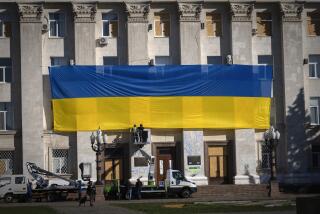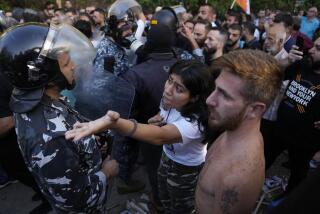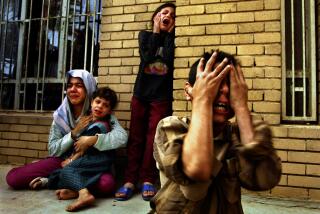Aligned With Iran, Kurds Torment Iraq
SULAYMANIYAH, Iraq — Flying from Kirkuk to this provincial capital in northeast Iraq, one can see earthen fortifications, sprouting up like tiny volcanoes, along the edges of the main highway.
The fortifications, positioned every couple hundred yards, with high dirt walls formed in a circle to protect the occupants, are outposts of Iraq’s Popular Army.
Even so, according to Iraqi officials and Western diplomats in Baghdad, the roads are not safe for Iraqi vehicles after dark--some say as early as 4 p.m. For this is the heart of Iraqi Kurdistan, and after sunset, the traffic is very much controlled--and intercepted--by the fierce Kurdish rebels who have been battling the Iraqi government for a generation.
Assertions by Iran two weeks ago that the Iraqi government had killed thousands of Kurds in a poison gas attack against the Kurdish town of Halabja, near the border with Iran, are only the latest in a long series of accusations of escalating cruelty by both sides in the conflict.
For years, the war in Kurdistan has taken a back seat to the Iran-Iraq War, with its “war of the cities,” the Persian Gulf tanker war and the ground offensives near the southern Iraqi city of Basra.
Focus Shifting
But in recent weeks, as the Iranians have become frustrated and neutralized by Iraqi military strength on other fronts, the focus of fighting has been squarely on the four northeastern Iraqi provinces that constitute Kurdistan, with an estimated 2.5 million people out of Iraq’s total of 14 million.
In response, Iraq has been forced to move two army corps to the north to deal with what has now become a joint Iranian-Kurdish problem. Although the corps are smaller than in other theaters of the war, “there is no doubt that the Iraqis have been forced to redeploy troops to the north from the south,” according to a Western diplomat in Baghdad.
10 Million People
The Kurds are one of the largest ethnic minorities in the Middle East, with more than 10 million people scattered over northern Iraq, northwestern Iran and southeastern Turkey. They have their own language and cultural heritage distinct from the Arab, Turkish and Persian peoples nearby.
In the mountainous villages that dot the border area between Iran and Iraq, life seems a primitive mixture of farming and herding. The Kurds still wear distinctive baggy gray trousers--a mode of dress left over from the era of the Ottoman Empire--with a wide sash and often a turban of gray-and-white check.
Roots in World War II
The struggle for an independent Kurdistan began in the closing days of World War II, but Iran under the Shah and governments in Baghdad have over the years proved too powerful an enemy.
One group, the Patriotic Union of Kurdistan, which is regarded as leftist, reached an agreement with the Iraqi government in 1983, but the truce foundered 10 months later over the union’s demand for the inclusion within their region of the Kirkuk oil fields, which still constitute 70% of Iraq’s petroleum wealth.
The war in the north transformed the political map of the region, with the Patriotic Union forming an alliance with Iran in November, 1986, and then agreeing to join forces with the other major Kurdish groups last year. According to diplomatic reports, the Kurds for the first time have been given sophisticated weapons by the Iranians.
Largest Kurdish Group
The largest Kurdish group is the Kurdish Democratic Party, controlled by the clan of Mustapha Barzani, a mullah who died in 1979. It reportedly has 10,000 fighters, based mainly in northern Kurdistan.
The Patriotic Union, with an estimated 3,000 to 4,000 fighters, is based in the region east of Sulaymaniyah. The Socialist Party of Kurdistan, supported mainly by Syria, has about 1,500 fighters and has gained notoriety by kidnaping foreigners.
Iran now claims to have captured a total of 1,000 square miles in the area, but this figure apparently includes mountainous terrain such as the sparsely inhabited Paijun salient, as well as towns such as Halabja and Mawat.
Direct Supplying
The capture of Mawat was important because, for the first time, it permitted the Iranians to supply the Patriotic Union’s headquarters directly.
The escalating wave of attacks against Iraqi positions prompted the Iraqi military to take Draconian steps against Kurdish villages, according to diplomats in Baghdad.
In the last year, Iraqi forces have systematically destroyed every Kurdish or ethnically Persian village near the border with Iran, relocating the residents to “controlled” new towns under Iraqi army authority.
In a recent news conference, the Kurdish governor of Sulaymaniyah province, Ali Jafar Barzani, said that 100 million Iraqi dinars (about $50 million at the unofficial exchange rate) had been set aside for the resettlement program, which he described as being “for the protection of the villages.”
Barzani maintained that no one is obligated to accept the move, and the villagers are expected to move back into their own homes when the fighting ends.
Diplomatic reports, however, suggest that the homes of Kurds have been destroyed with huge explosive charges, reducing entire villages to rubble.
‘We Call Them Treacherous’
Speaking of the Kurdish rebel groups, Barzani said they are regarded as “bandits and disliked by the Kurdish people. We call them treacherous--agents of Iran.”
Speaking in a radio broadcast from London, Jalal Talabani, the head of the Patriotic Union, said that his forces had “liberated” all of the villages around Sulaymaniyah, leaving only the major towns in Iraqi hands.
“The Iraqi army is tired now,” Talabani said. “It has suffered a lot of casualties against Iran. It is also not defending a just cause in Iraqi Kurdistan. The Iraqi army is the invader army of Kurdistan. They are losing daily and suffering from their very aggressive war against the Kurdish people. We think their morale is very low.”
Western diplomats based in Baghdad believe that in the northern war, the Kurds are taking an equal part in the recent fighting alongside Iran’s Revolutionary Guards. The mountain villages being captured by the Iranians and their Kurdish allies are difficult to defend because they offer little maneuvering room for tanks and aircraft.
Threat to Capital
One Western analyst said that the Iraqi military would probably cede the border region to Iran, if it could, to avoid having to commit troops to an unwinnable enterprise. But the threat to Sulaymaniyah, a provincial capital, is too great to ignore, he said.
The analysts said that with Iraq’s massive superiority in armor and air force, there is little potential threat to the Kirkuk oil fields and the oil pipeline to Turkey, although last year the rebels attacked a degassing plant in Kirkuk.
So far, according to Iraqi officials, the rebels have not managed to attack Sulaymaniyah, but the city has been shelled repeatedly by Iran.
The new, concrete-block suburbs rising on the city’s outskirts to house the resettled Kurds are a constant reminder, however, of how vulnerable Iraq’s forces in the region are.
Times staff writer Charles P. Wallace was recently on assignment in Iraq.
More to Read
Sign up for Essential California
The most important California stories and recommendations in your inbox every morning.
You may occasionally receive promotional content from the Los Angeles Times.










